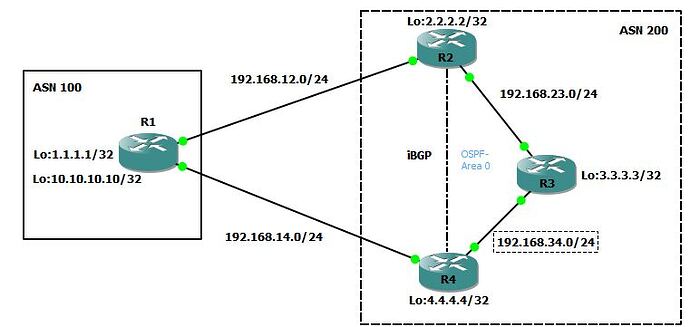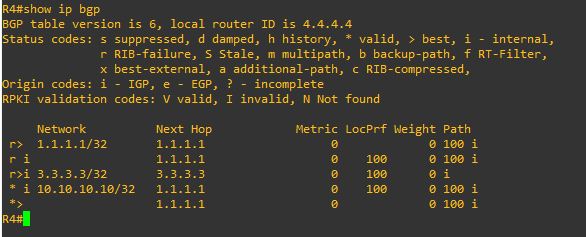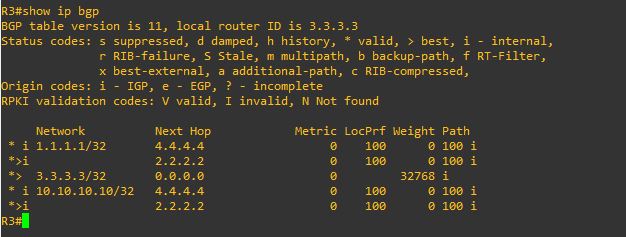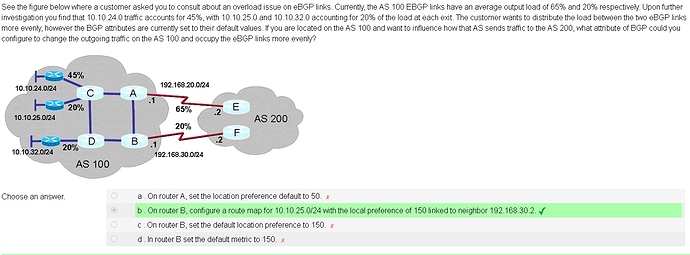Hello Rene/Las,
On above i have pasted my topology with necessary configuration. The prefix 1.1.1.1/32 is coming from R1 and get injects in to AS -2 with local preference configured on R3.
You can use local preference to choose the outbound external BGP path.
Local preference is sent to all internal BGP routers in your autonomous system.
Default value is 100.
The path with the highest local preference is preferred.
The second line is very confusing and my question is also to know about the LP propagation between the routers participating in AS-2.
Adding my observations once configured the LP policy on R3 router is mentioned below.
- Before implementing LP configurations ,R2 can able to advertise the same route 1.1.1.1/32 towards R4.
- After LP configured,only the highest LP tagged route will be there in R4’s BGP table which never allows R2 to advertise the same route towards neighbor belongs to same AS -2.
Why it is like that ? Which bgp message is using for that attribute propagation to inform all i-BGP neighbors about this preferred exit entry?
And i think because of this we won’t receive two routes from different path in bgp table of R4 right? Can be a reason to block maximum path configuration for load sharing using two paths?
Network Next Hop Metric LocPrf Weight Path
* i 1.1.1.1/32 3.3.3.3 0 100 0 1 ?
*>i 2.2.2.2 0 100 0 1 ?
This is pre LP implementation Maximum path because we have two path in BGP table achieved load balancing.
Network Next Hop Metric LocPrf Weight Path
*mi 1.1.1.1/32 3.3.3.3 0 100 0 1 ?
*>i 2.2.2.2 0 100 0 1 ?
1.0.0.0/32 is subnetted, 1 subnets
B 1.1.1.1 [200/0] via 3.3.3.3, 00:00:39
[200/0] via 2.2.2.2, 00:00:39
B 192.168.13.0/24 [200/0] via 3.3.3.3, 00:00:39
[200/0] via 2.2.2.2, 00:00:39
Router#
Let me add few more points here below
R2#show ip bgp neighbors 192.168.12.1 received-routes
Network Next Hop Metric LocPrf Weight Path
- 1.1.1.1/32 192.168.12.1 0 0 1 ? ----------------> Received routes but not advertising from here towards 4.4.4.4 (R4) after higher LP has implemented on R3.
R2#show ip bgp neighbors 4.4.4.4 advertised-routes
Network Next Hop Metric LocPrf Weight Path
*> 22.22.22.22/32 192.168.12.1 0 0 1 ? ------------> blank for 1.1.1.1/32
r> 192.168.12.0 192.168.12.1 0 0 1 ?
*> 192.168.13.0 192.168.12.1 0 0 1 ?
My question is why 1.1.1.1/32 is valid route only in R2 …On what basis R2 took decision to keep 1.1.1.1/32 as valid route not best .If it becomes best it is supposed to advertise from here right?
On what basis R2 took that decision to keep 1.1.1.1/32 as valid only .So i think we need to know the BGP propagation of LP attribute using which type of messages in AS-2.
Correct me if i am wrong in my understanding.
Regards
Unni





